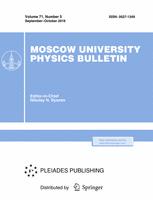In contrast to the other works by the present author on high-temperature superconductivity, in this paper an exactly solvable problem is analyzed in detail and an elementary asymptotic leading to superconductivity is obtained. In the model suggested, a phase transition of "zero order" is observed, i.e., a free-energy jump occurs at the point where heat capacity goes to infinity. This work uses an analogy with the BCS (Bardeen—Cooper—SchriefFer) theory—short-range attraction of electrons of approximately the same energy. The temperature at which superconductivity occurs depends on the relation between the magnitude of attraction and the distance between bands. An example is presented to demonstrate that by reducing the distance between the bands at an attraction of about 0.01 eV, one can achieve phase transition at t°~100 K.
Department of Quantum Statistics and Field Theory, Department of Physics, Moscow State University, Moscow, 119991, Russia



